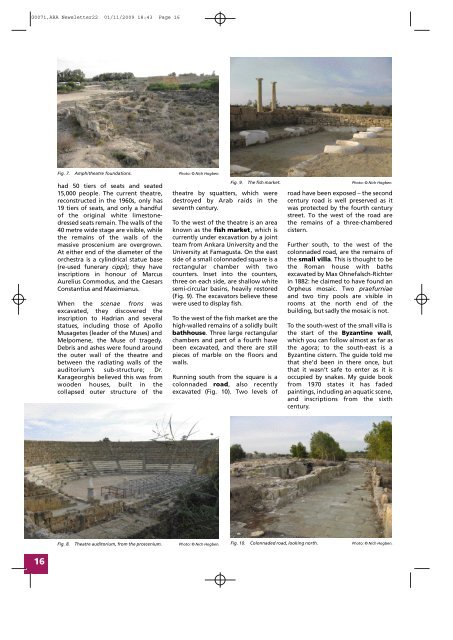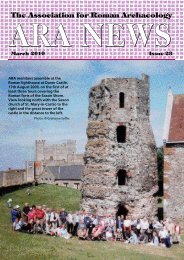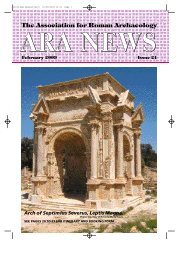G0071,ARA <strong>Newsletter</strong><strong>22</strong> 01/11/2009 18:43 Page 16Fig. 7. Amphitheatre foundations. Photo: © Nich Hogben.had 50 tiers of seats and seated15,000 people. The current theatre,reconstructed in the 1960s, only has19 tiers of seats, and only a handfulof the original white limestonedressedseats remain. The walls of the40 metre wide stage are visible, whilethe remains of the walls of themassive proscenium are overgrown.At either end of the diameter of theorchestra is a cylindrical statue base(re-used funerary cippi); they haveinscriptions in honour of Marc u sAurelius Commodus, and the CaesarsConstantius and Maximianus.When the s c e n a e f ro n s w a sexcavated, they discovered theinscription to Hadrian and severalstatues, including those of ApolloMusagetes (leader of the Muses) andMelpomene, the Muse of tragedy.Debris and ashes were found aroundthe outer wall of the theatre andbetween the radiating walls of thea u d i t o r i u m ’s sub-stru c t u re; Dr.Karageorghis believed this was fromwooden houses, built in thecollapsed outer stru c t u re of thetheatre by squatters, which wered e s t royed by Arab raids in theseventh century.To the west of the theatre is an areaknown as the fish market, which iscurrently under excavation by a jointteam from Ankara University and theUniversity at Famagusta. On the eastside of a small colonnaded square is arectangular chamber with twocounters. Inset into the counters,three on each side, are shallow whitesemi-circular basins, heavily restored(Fig. 9). The excavators believe thesewere used to display fish.To the west of the fish market are thehigh-walled remains of a solidly builtbathhouse. Three large rectangularchambers and part of a fourth havebeen excavated, and there are stillpieces of marble on the floors andwalls.Running south from the square is acolonnaded ro a d, also re c e n t l yexcavated (Fig. 10). Two levels ofFig. 9. The fish market. Photo: © Nich Hogben.road have been exposed – the secondcentury road is well preserved as itwas protected by the fourth centurystreet. To the west of the road arethe remains of a three-chamberedcistern.Further south, to the west of thecolonnaded road, are the remains ofthe small villa. This is thought to bethe <strong>Roman</strong> house with bathsexcavated by Max Ohnefalsch-Richterin 1882: he claimed to have found anOrpheus mosaic. Two praefurniaeand two tiny pools are visible inrooms at the north end of thebuilding, but sadly the mosaic is not.To the south-west of the small villa isthe start of the Byzantine wall,which you can follow almost as far asthe agora; to the south-east is aByzantine cistern. The guide told methat she’d been in there once, butthat it wasn’t safe to enter as it isoccupied by snakes. My guide bookf rom 1970 states it has fadedpaintings, including an aquatic scene,and inscriptions from the sixthcentury.Fig. 8. Theatre auditorium, from the proscenium. Photo: © Nich Hogben.Fig. 10. Colonnaded road, looking north. Photo: © Nich Hogben.16
G0071,ARA <strong>Newsletter</strong><strong>22</strong> 01/11/2009 18:43 Page 17Fig. 11. Large villa, olive press and strainer. Photo: © Nich Hogben. Fig. 13. Partially cleared cistern. Photo: © Nich Hogben.Further south-west is the large fifthcentury villa, excavated by a Frenchteam in 1969. This two-store ymansion has an apsidal receptionhall, an inner court y a rd, livingquarters and a well. There are smallsections of painted plaster on thewalls of one corridor, and fragmentsof carved stone panels around thecourtyard. The building was laterused as an oil mill: in the receptionhall there is a big olive press and astrainer (Fig. 11).South-west of the large villa is theKampanopetra basilica, comprisingtwo courtyards, a three-aisled churchwith rooms running down either sideand apses at the end, and behind theapses, baths. The better preservedcourtyard is surrounded by roomsand has a well in the middle. Thereare empty sarcophagi in the southernaisle of the church. In the nave’s apsethere is a synthronon – a semi-circularplat<strong>for</strong>m, stepped like a theatre, <strong>for</strong>the clerg y ’s thrones. The wellpreservedopus sectile flooring in thebaths includes a marvellous circularshield pattern made from triangularpieces (Fig. 12).It is only a short walk from the bathsto the sea. The site of the harbour isnearby; visitors arriving at ByzantineConstantia from the sea may havevisited the basilica and its baths <strong>for</strong>ritual purification be<strong>for</strong>e enteringthe city.To the south of the Byzantine wall isan overgrown area known as thegranite <strong>for</strong>um, due to the numberof massive columns made fro mEgyptian granite lying around thearea; their presence was recorded byRichard Pococke, who visited the sitein 1738. Nearby is a deep octagonalfeature of uncertain purpose; my1970 guide book speculates that itmight have been a water clock.The Basilica of St. Epiphanius, thelargest in Cyprus, is said to have beenbuilt while St. Epiphanius was bishopof C o n s t a n t i a ( AD 3 86 - 403). Theoriginal church had seven aisles: awide nave and three narrow aisles oneither side, with apses on the naveand two inner aisles. The nave’s apsehas a synthronon; behind it runs as e m i - c i rcular passage, joining thetwo aisles that flank the nave. Therea re strips of mosaic floor in astructure to the north-east of thenave. Geometric mosaic is also visibleon the floor of a later, small chapel,to the north-west of the basilica’snave.The great cistern, or vouta, to then o rth end of the a g o r a is animpressive structure. The soil hasbeen cleared from half of thebuilding, revealing three rows ofsquare pillars, which would probablyhave supported a vaulted ceiling(Fig. 13).The agora is also called the stone<strong>for</strong>um, to distinguish it from thegranite <strong>for</strong>um. One column stands atthe north end, near to the cistern.The agora is overgrown, but at thesouth-east end the remains ofbuildings, perhaps shops, are visible,and lower drums from columns thatwould have colonnaded the agoraare in place.Fig. 12. Kampanopetra basilica baths. Photo: © Nich Hogben. Fig. 14. Temple of Zeus, from the agora. Photo: © Nich Hogben.17
- Page 2 and 3: G0071,ARA Newsletter22 01/11/2009 1
- Page 4 and 5: G0071,ARA Newsletter22 01/11/2009 1
- Page 6 and 7: G0071,ARA Newsletter22 01/11/2009 1
- Page 8 and 9: G0071,ARA Newsletter22 01/11/2009 1
- Page 10 and 11: G0071,ARA Newsletter22 01/11/2009 1
- Page 12 and 13: G0071,ARA Newsletter22 01/11/2009 1
- Page 14 and 15: G0071,ARA Newsletter22 01/11/2009 1
- Page 18 and 19: G0071,ARA Newsletter22 01/11/2009 1
- Page 20 and 21: G0071,ARA Newsletter22 01/11/2009 1
- Page 22 and 23: G0071,ARA Newsletter22 01/11/2009 1
- Page 24: G0071,ARA Newsletter22 01/11/2009 1




